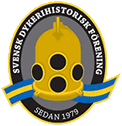In part 7 we take us from year 1939 – 1956.
(A good source in creating this chronology has been SPUMS Journal Volume 29 No.2 June 1999. Spums Archive
If you have rights to any of the images used to illustrate the material, please contact us via our contact form >, we will give you credit for the image, or remove it if you wish.)
1939 Louis Mari de Corlieu
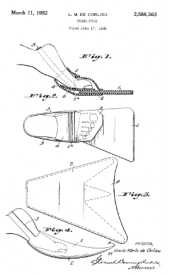
de Corlieu is attributed as the inventor of the first elastic swim fins. He began serial production of his fins in 1939. The fins were used, among others, by Jaques Yves Costeau during the production of the world’s first underwater film, Shipwreck, in 1943 and by US forces on D-Day 1944. Note. the picture shows a further development from 1952 81.
1939 Hans Hass
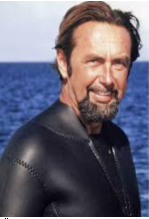
Austrian Hans Hass published his first book, Diving to Adventure, with underwater photo 1939. In 1940 came his first underwater film, Pirsch unter Wasser. In 1941, Hass moved to Berlin, where he started the association ”Expedition für biologische Meereskunde”.
Thanks to his many lectures, in 1942 Hass was able to buy the sailing ship Seeteufel, His idea was to use the ship for his diving/photo expeditions in the Mediterranean, but because of the ongoing war, the ship could not leave the port of Rostock / Warnemünde. When the Red Army besieged the city in 1945, they seized the ship and took it to Leningrad (St. Petersburg) 82, 83.
Hass instead rented the ship Piraeus and sailed, filmed and photographed in the Aegean Sea.
In the spring and summer of 1943, Hass spent several months at Stazione Zoologica in Naples and Capri to study and collect Bryozoa, aquatic invertebrates, for his doctoral dissertation in zoology. In February 1944, he completed his dissertation and completed his doctorate.
Hass presented his energy hypothesis, which was the focus of his work in recent years. The hypothesis suggests that the behavior of all life forms – human, non-human animals and plants, are of common origin.
In combination with leadership strategies, Hass published in 1969 a paper on similarities with evolution. In the 1970s he dealt with environmental and commercial themes and was appointed professor at the University of Vienna. In 1983, he began long-term studies and guidance on predatory animal instincts in his professional life. In a business-economical way, he consolidated marine biology, behavioral research and management theories in one context. From his point of view, his energy theory could not be disproved.
Hass also made several diving and photo-technical innovations over the years 84.
- 1938: New lightweight uv-camera for ROBOT
- 1940: First uv-photo (Catalina Island, USA) and uv-movie
- 1941: Development of technic for divining for research, industry and sport.
- 1944: Construction of a heliox-rebreather (prototype)
- 1949: New system for deep sea film and photo (named Bathyopthalm)
- 1949: Patent all over the world for a new method for fishing with radio signals (named Elektro-Marina)
- 1949: System Hans Hass swim-fin designed of Hans Hass and produced by Semperit in Vienna from 1949 and from 1951 of Baracuda from Hamburg and Heinke i London.
- 1950: Uw-camera house ”Leica System Hans Hass” with electronic flash
- 1954: Uw-camera house ”Rolleimarin System Hans Hass”, also asa stereo camera
- 1955: Co-development and marketing of a diving watch ENICAR Sherpa
- 1956: New patented design of a swim-fin (named Superfish)
- 1973: Building of an uw-habitat (Almeria, Spanien)
- 1977: Construction of a small uw-habitat together with the german company BRUKER. The habitat was to be used for deep sea research, tourism and oilprospekting.
- 1983: Development and marketing of an innovative decompression computer (named ”Deco-Brain”)
(Redacted note. 1974 was Hass Swedish Sports Diving Association’s guest and lecturer for sports diving clubs.)
1940 Dottie Frazer
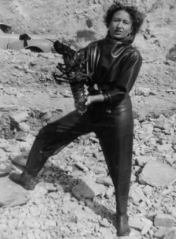
1940-talet Jacques-Yves Cousteau & Emile Gagnan
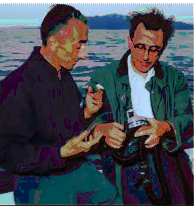
Jacques-Yves Cousteau entered the École Navale (Naval Academy) in Brest in 1930. During World War II he was an aide to the inventor Emile Gagnan, and together in 1943, they designed a regulator that regulated the amount of inhalation air for the diver based on how much the diver was breathing, a demand valve. The Aqualung, as it was called, became the first commercially viable diving equipment for sport diving. The ship Calypso, which had previously been a minesweeper and then operated as a ferry between Malta and Gozo, had been purchased by banker Loel Guiness. For the symbolic sum of 1 Franc per year, he let Cousteau rent the ship for one franc per year. With his team, Costeau traveled around to interesting dive sites, which were later described in both books and films, which became particularly important for the interest in sports diving and marine biolog86.
1940 Dr. Eugenie Clark
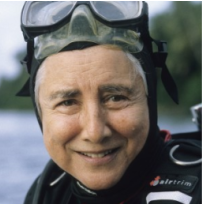
Eugenie Clark, also known as ”The Shark Lady”. Dr. Clark was known throughout the world as the scientific expert on fish, and has also had some fish named after her. However, her passion was sharks. Dr. Clark has been named Honorary Doctor on three occasions and received awards from the National Geographic Society, the Explorers Club, the Underwater Society of America, the American Littoral Society, the Gold Medal Award of the Society of Women Geographers and the President’s Medal at the University of Maryland. She has authored three books and over 160 scientific and popular science articles.
Dr. Clark learned to dive in the 1940s at the Scripps Institution of Oceanography. Unfortunately, she and another female scientist were prohibited from participating in overnight diving trips – which limited their ability to conduct research. After working at the American Museum of Natural History, Dr. Clark Cape Haze Marine Laboratory (now Mote Marine Laboratory) 1955 to devote more time to shark research.
She did 72 deep dives. Her latest research project concerned the behavior of tropical sandfishes and deep sea sharks. These studies have been presented in 12 articles she has written for the National Geographic magazine 87
.1942 Victor Berge
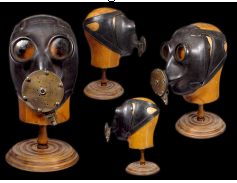
Sweden’s and probably the world’s most odd fish in diving history must be Victor Berge.
He was born in Bollnäs in 1891, went to sea early and ended up, after several adventures, as a pearl diver in heavy diving equipment in Indonesia 88 .
Victor Berge became known throughout the world for his book ”My Life as a Pearl Fisherman” which was first published in English. A bestseller in the 1930s, which was translated into 18 languages. Berge’s second book ”The danger is my life” was published in 1951 and it was also translated into several languages 89 .
Berge claimed that he invented the diving equipment ”now used in rescue operations around the world.” Berge showed his invention to a friend at the Ford Motor Company in the United States in 1941, where some improvements to the demand valve were made before Berge produced 50 masks to take to Indonesia. That same year, before leaving the US, he demonstrated the mask for the US Navy, which was impressed by its versatility and simplicity.
Here are two conflicting tasks. In 1941, Berge applied for a US patent for his diving mask and device design (U.S. Patent 2303155) 90 . The Berge Mask was manufactured by the Ohio Rubber Co. and was delivered with either a modified flight controller or free flow. During World War II, Berges’ mask was part of the ”USN Standard Shallow Water Diving Outfit” (diving down to 13 meters) and was also provided to the Allies under the so-called Lend-Lease scheme of military support.
Another version says the following;
Berge did not patent the mask design before rushing back to Indonesia, just as the Japanese entered the war. When his family and friends in the United States had heard nothing about him during the war years, they assumed he was dead (he sat, according to himself, in captivity).
After entering the war in late 1941, the US Navy decided to use Berge’s unpatented design, especially since they could not come into contact with Berge himself. The masks were manufactured in Willoughby Ohio by the Ohio Rubber Company and marketed as ORCO Diving Mask.
A feature of the Berge mask (ORCO) was the dual redundancy air supply mechanism. The demand valve had a push button arrangement on the front which allowed the diver to force air into the nozzle. This is available today on all modern diving equipment. Alternatively, by using another mounted bypass valve, a continuous air flow around the diver’s face could be provided, where the excess air was forced out of the mask due to the overpressure.
Air supply was usually provided with medium pressure via air hose from the surface of a high-pressure air bank, via a pressure reducer or from a manual air pump 91 .
Victor Berge died at the age of 83 in Stockholm. He was then exhausted and, according to his own will, was buried at Ockelbo cemetery in 1974. The funds left behind were not enough for a headstone.
Initiated by Birgitta Persson ( district nurse in Ockelbo) in 1976 a collection was made for a tombstone where it says Pearlfisher Victor Berge 1891-1974. 92
1944 Christian J Lambertsen
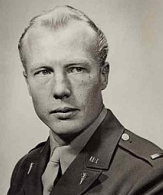
Lambertsen was an American specialist in environmental and scuba medicine who served in the US Army Medical Corps from 1944 to 1946. He invented, according to the US Navy, the first UV recirculation device and showed it to the US Navy, which, however, found it uninteresting. In 1946, he demonstrated the equipment for the Office of Strategic Services, the OSS, the forerunner of the Central Intelligence Agency, CIA. Not only did the OSS buy into the concept, they hired Major Laberts to build and lead the scuba diving program in their maritime unit. Mainly, Lambert was responsible for developing the US Navy Diver’s Rebreathers in the early 1940s and the underwater training program. He also had primary responsibility for the selection of divers sent out to war service.
Lambertsen designed a series of rebreathers and first called his invention a respirator. Later, after the war, he called it Laru (abbreviated to the Lambertsen Amfibious Respiratory Unit) and finally, in 1952, he changed his invention’s name to SCUBA (Self Contained Underwater Breathing Apparatus), which has also become the international name for diving equipment without air supply from surface 93 .
From 1946 to 1953, Lambertsen worked as a professor of pharmacology at the Department of Pharmacology at the University of Pennsylvania School of Medicine, but he spent a year as a visiting research lecturer from 1951 to 1952 at the Department of Physiology at University College London, England. Lambertsen spent the 1950s concentrating on national research needs in underwater medicine. He returned for a time as Professor of Pharmacology and Experimental Therapy at the University of Pennsylvania School of Medicine in 1962. He was also appointed Professor of Medicine in 1972 and Professor of the University of Pennsylvania School of Veterinary Medicine in 1976. Each of these appointments was maintained until 1987. In 1985 he became Emeritus Distinguished Professor of Environmental Medicine at the University of Pennsylvania. Lambertsen was one of the front figures in diving medicine and in 1963 he took over the editorial board for a series of ”proceedings” in ”Under water physiology” which are today regarded as reference works in the subject. The own research, up to the pension, focused on the effects of Dr. Lambertsen’s ”Predictive Studies Series”, which ranges from 1969 with the TEKTITE I to 1997 habitat, researched many aspects of people in extreme environments 94 .
oxygen in the lungs.1945 Arne Zetterström
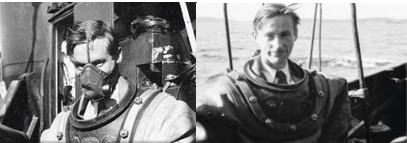
Arne Zetterström was a Swedish dive pioneer, best known for his research on the gas mixture hydrox, a mixture of hydrogen (hydrogen) and oxygen (oxygen). Arne Zetterström, just 28 years of age, was killed by a tragic mistake in connection with an experimental dive with hydrox to 160 m, which was deeper than the prevailing world record in diving, outside Nynäshamn on 17 August 1945. Due to unfortunate circumstances and misunderstandings, he was picked up faster than what the ascent tables prepared by Professor Yngve Zotterman prescribed. What happened was that the dive platform that Zetterström was on and was submerged from the stern of the naval diving vessel HMS Belos, was provided with a thin line that would prevent the platform from starting to rotate. The rope, which was to be hauled in by hand, was operated from the bow. For this task, two conscripted crew members who had no knowledge of diving were appointed. The two crewmen eventually got tired of their task and connected the rope to a motor-driven game and did not then notice that they pulled the platform towards but with this rope. When the lift wire, which was marked every ten meters for this depth, showed that the platform was at fifty meters depth, it was in reality only 5 to 10 meters deep. When this was discovered after a few minutes or so, the line was released and the platform was immediately lowered to 50 meters, but Zetterström’s life could not be saved. The doctor who participated in the autopsy a few days later notes that the heart’s cavities were filled with large amounts of gas, which indicated a severe case of decompression sickness. However, the direct cause of death is believed to have been acute hypoxemia, lack of oxygen, as the gas mixture which Zetterström breathed at the time was intended for a depth of 50 meters and the oxygen content at a depth of 5-10 meters was thus reduced to around 4%. The Navy then discontinued its experimental activities on hydrox diving. They were not resumed until 1979 when Hans Örnhagen, on the initiative of the Naval Medical Institute
the Research Council and the Board of Technical Development (STU), which financed animal experiments at Lund University and later human exposures at the Marine Diving Center, Berga.
Zetterström also made several inventions, including the universal tool for divers, the Zetterström valve for diving helmets and Zetterström’s recoil-free flush nozzle. The latter was used, among other things, to flush the tunnels for the lifting cables during the salvage of Vasa 95, 96, 97 .
Despite the tragedy, it’s hard to not smile. Look at the right image, maybe it is arranged, but still, it shows some of the dress code of the time. Arne Zetterström, wearing a heavy-duty suit and underneath wearing a white shirt and a tie.
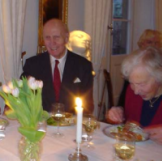
1947 Lotte Hass
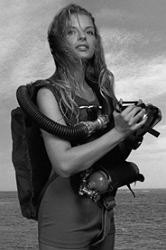
When Hans Hass was looking for a secretary for his office in Vienna in the summer of 1947, Lotte Baierl got the job. She had just finished high school and was a big fan of Hass’s work. Hoping to be allowed to participate in Hass’s next expedition, she trained in swimming pools, dived and photographed in the lakes around Vienna, where she received support and was trained by Hass’s assistant Kurt Schaefer.
Hans Hass was generally opposed to women participating in his expeditions. Lotte, who not only learned to dive but also to become a skilled underwater photographer, repeatedly asked to join the next expedition. Hass finally gave in when the film company Sascha Wiener insisted that Hass’s next documentary would be more attractive to a wider audience with a female protagonist.Although the film became popular, it also received criticism thanks to Lotte’s participation. Many believed that Hass had gone from his scientific interests to making underwater films with pin-up elements.
At the end of 1950, Hans and Lotte became a couple and married (His second marriage) bourgeois and then, in 1963, the church.
During the 1950s, Lotte participated in two further expeditions with the three-masted schooner Xarifa and she and Hans hosted two British TV series, Diving to Adventure and The Undersea World of Adventure. After giving birth to the couple’s daughter in 1958, she largely withdrew from public life.
År 2000 blev hon invald i Women Divers Hall of Fame och International Scuba Diving Hall of Fame98.
1955 Carl Magnus Hesser

Hesser began his medical studies at the Karolinska Institutet in 1938. The first study trip went to the United States, where he was a guest researcher at the Department of Physiology at the University of Rochester N.Y. where perhaps the foremost researchers of the time in the field of respiratory physiology were active. Hesser conducted experiments on effects on blood circulation in the case of hypertension and suppression in the lungs. These studies then continued in Sweden and formed the basis for his dissertation. After his dissertation, he continued his studies in aviation and naval physiology and eventually became professor at the department. The Swedish Navy was, at the end of the 40s, the beginning of the 50s in the concept of introducing scuba diving and Hesser was given the opportunity during his USA trip to discuss the dive form with Christian Lambertsen who designed the diving equipment used during World War II. Lambert was also responsible for the training of divers and their participation in the war (See above).
Back in Sweden, Hesser was commissioned by the Navy to rework the medical part of the ”Diving Service Instructions for the Navy” which was also used civilly. This edition was in use 1953 – 1958.
After World War II, C M Hesser, together with his colleague Hilding Bjurstedt, was commissioned by the State Board of Aeronautical Research to design an environmental physiology laboratory at Karolinska Institutet. This laboratory was equipped with high and low pressure chambers and human centrifuge for aerospace operations. Sweden was then given a university supplement to the activities conducted at Dyktankhuset since 1934.
Hesser was one of those who initiated the introduction of free ascent as an individual rescue method from a submarine. The ascent tank in Karlskrona where the exercises were carried out from a depth of 20 meters had at that time no high compression chamber, and no water purification unit, which sometimes made monitoring of the exercise difficult. After a couple of, not serious, accidents occurred, Hesser requested that the exercises be interrupted for a year so that these deficiencies could be corrected.
In 1971, the European Undersea Biomedical Society, EUBS, was founded. Hesser was named its first president, which he was (1971-1972). The first meeting after the formation was held in 1973 in Stockholm.
Hesser was also, for a period, chairman of the Commission on Underwater Physiology and Medicine, established by the International Union of Physiological Sciences in 1976 99 .
References
81. Lois de CorlieuVisited 20200504.
82. Hans Hass. Visited20200428.
83. Seeteufel. Visited 20200428.
84. Hans Hass. Visited20200428.
85. Dottie Fazer. Visited 20200501.
86. Cousteau, Gagnan. Visited 20200501
87. Euigine Clark. Visited 20200504.
88. Victor Berge. Visited 20200501.
89.Victor Berg. Visited 20200501
90. Victor Berge. Visited 20200501.
91.Victor Berg. Visited 20200501.
92. Victor Berge. Besökt 20200501.
93. Lambertsen. Visited 20200430.
94.LambertsenVisited 20200430.
95. Arne Zetterström. Visited 20200429.
96. Arne Zetterström
97. Speech by Carl Erik Hesser (Via Hans Örnhagen).
98.Lotte Hass. Visited 20200614.
99. Speech by Carl Erik Hesser (Via Hans Örnhagen).
